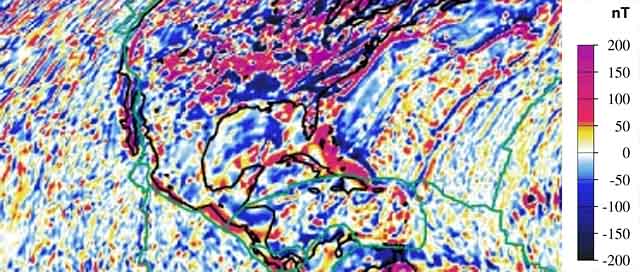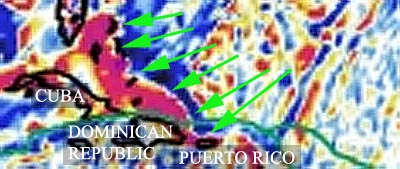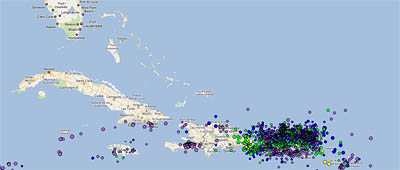Atlantic Magnetic Anomaly Signaling Disaster?

The National Oceanic and Atmospheric Administration’s National Geophysical Data Center reveals a magnetic crustal field model of the earth. It shows a magnetic anomaly in the Atlantic Ocean off the coast of Puerto Rico and the Dominican Republic.

There are a number of areas across the planet where there appear to be boundaries of extremes while mapping the crustal magnetic field strength.
The boundary off the north coast of Puerto Rico and the Dominican Republic for example reveal opposing magnetic field differences of +200 nT to -200 nT within short distances, which follow a clear path along the ocean floor.
‘nT’ stands for nanotesla. The tesla is a unit of magnetic field strength.

A Google Earth map of the ocean floor region north of Cuba, the Dominican Republic, and Puerto Rico, when compared with the region of positive-to-negative flipped magnetic field strength, shows a boundary region of seafloor which is geographically fairly steep.

Looking at some of the historical earthquakes in the region as reported from the IRIS earthquake monitor, there is an obvious region of very high earthquake activity off the coast of Puerto Rico which itself is located along a very steep seafloor ridge or trench. Could we be looking at an eventual disaster in this region?
Pole Shift
>> Books and Reference on the subject
(amzn)
The Puerto Rico trench hazard could someday result in a horrific collapse, a submarine landslide, and would produce a tremendous tsunami in the region which would spread widely across that part of the Atlantic ocean.
How to prepare for a tsunami?
Have a plan how you would escape to higher ground, or further inland. If you’ve already thought about it and planned a route, and you recognize the onset of the tsunami, so long as you beat the crowd you will probably be OK. Know how to recognize that a tsunami is about to happen (major earthquake while on the coast – or water withdrawing rapidly away from the coast).
The regions of earth’s crustal magnetism that have negative field strength boundaries that are directly adjacent to positive field strength areas, may or may not have any real-world effects, but it is interesting to look at and to think about how it may relate with other geophysical attributes of the region.
